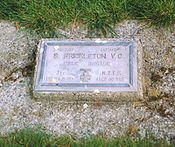
Samuel Frickleton
Encyclopedia

Victoria Cross
The Victoria Cross is the highest military decoration awarded for valour "in the face of the enemy" to members of the armed forces of various Commonwealth countries, and previous British Empire territories....
(1 April 1891 – 6 August 1971) was a non-commissioned officer
Non-commissioned officer
A non-commissioned officer , called a sub-officer in some countries, is a military officer who has not been given a commission...
in the New Zealand Expeditionary Force
New Zealand Expeditionary Force
The New Zealand Expeditionary Force was the title of the military forces sent from New Zealand to fight for Britain during World War I and World War II. Ultimately, the NZEF of World War I was known as the First New Zealand Expeditionary Force...
, and recipient of the Victoria Cross
Victoria Cross
The Victoria Cross is the highest military decoration awarded for valour "in the face of the enemy" to members of the armed forces of various Commonwealth countries, and previous British Empire territories....
, the highest award of the British Commonwealth for gallantry "in the face of the enemy", during the First World War.
Biography
Frickleton was born in SlamannanSlamannan
Slamannan is a village in the south of the Falkirk council area in Central Scotland. It is south-west of Falkirk, east of Cumbernauld and north-east of Airdrie....
, Stirlingshire
Stirlingshire
Stirlingshire or the County of Stirling is a registration county of Scotland, based around Stirling, the former county town. It borders Perthshire to the north, Clackmannanshire and West Lothian to the east, Lanarkshire to the south, and Dunbartonshire to the south-west.Until 1975 it was a county...
, Scotland. He immigrated to New Zealand in 1908, and worked as a coal-miner in Blackball
Blackball, New Zealand
Blackball is a small town on the West Coast of the South Island of New Zealand, approximately 29 km from Greymouth.Blackball was named after the Black Ball Shipping Line, which leased land in the area to mine for coal. It was formerly known as Joliffetown and Moonlight Gully.Blackball is a centre...
in the South Island. At the onset of the First World War, Frickleton and his four brothers joined the New Zealand Expeditionary Force
New Zealand Expeditionary Force
The New Zealand Expeditionary Force was the title of the military forces sent from New Zealand to fight for Britain during World War I and World War II. Ultimately, the NZEF of World War I was known as the First New Zealand Expeditionary Force...
, and all fought at Gallipoli
Gallipoli
The Gallipoli peninsula is located in Turkish Thrace , the European part of Turkey, with the Aegean Sea to the west and the Dardanelles straits to the east. Gallipoli derives its name from the Greek "Καλλίπολις" , meaning "Beautiful City"...
in 1915. After the battle, Frickleton was invalided home from Gallipoli and subsequently discharged as medically unfit for active service. Having recovered, he re-enlisted in 1916, and was posted to France as a lance-corporal in the 3rd Battalion, New Zealand Rifle Brigade
New Zealand Rifle Brigade
The New Zealand Rifle Brigade , affectionately known as The Dinks, was formed on 1 May 1915 as the 3rd Brigade of the New Zealand Division, part of the New Zealand Expeditionary Force. During the first World War it fought in Egypt, against the Senussi, and then on the Western Front...
.
Frickleton was awarded a Victoria Cross of his action on 7 June 1917 at Messines
Mesen
Mesen is a city located in the Belgian province of West Flanders. The municipality only comprises the town of Mesen proper. On January 1, 2006, Mesen had a total population of 988. The total area is 3.58 km² which gives a population density of 276 inhabitants per km².Mesen is the smallest city in...
, Belgium
Belgium
Belgium , officially the Kingdom of Belgium, is a federal state in Western Europe. It is a founding member of the European Union and hosts the EU's headquarters, and those of several other major international organisations such as NATO.Belgium is also a member of, or affiliated to, many...
. The citation notes that "[a]lthough slightly wounded, Lance Corporal Frickleton dashed forward at the head of his section, rushed through a barrage and personally destroyed with bombs an enemy machine gun and crew, which were causing heavy casualties. He then attacked the second gun, killing the whole of the crew of twelve. By the destruction of these two guns he undoubtedly saved his own and other units from very severe casualties and his magnificent courage and gallantry ensured the capture of the objective."
Frickleton was severely wounded later in the war, and was evacuated to England. After the war, he remained in the Army. He retired with the rank of Captain in 1927, when he joined the Territorial Force.
Frickleton married in 1921, and one child, a son, was born in 1928.

His Victoria Cross was on display at the QEII Army Memorial Museum
QEII Army Memorial Museum
The National Army Museum is the museum of the New Zealand Army. It was formerly known as the Queen Elizabeth II Army Memorial Museum. It is situated 94 minutes south of Taupo on State Highway One, on the southern side of the small military town of Waiouru. The 1300 square metre museum is...
, Waiouru, New Zealand,
when it was one of nine Victoria Crosses that were among a hundred medals stolen from the museum in December 2007. On 16 February 2008 New Zealand Police announced all the medals had been recovered.

